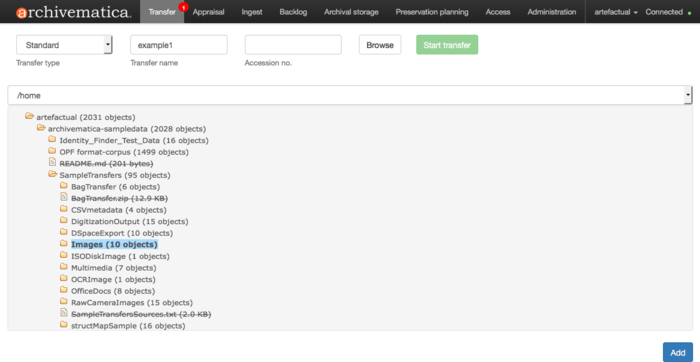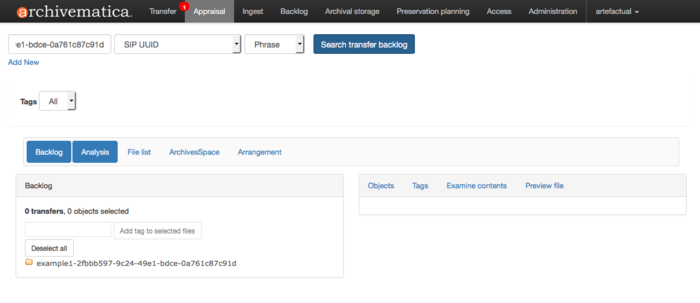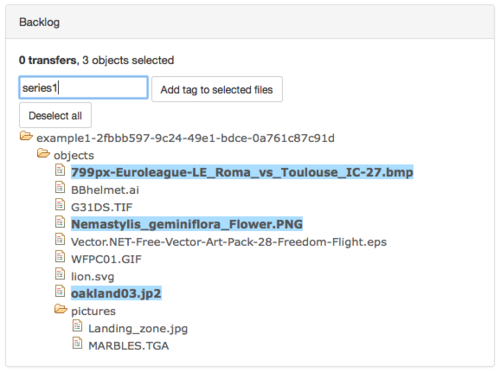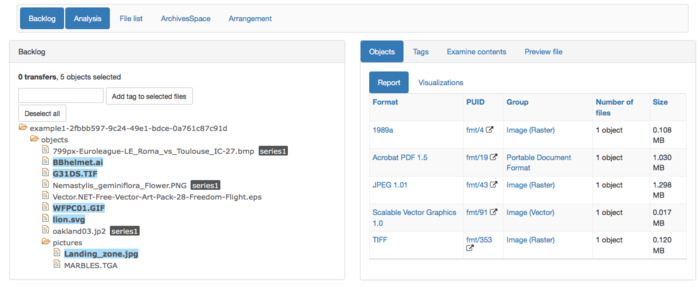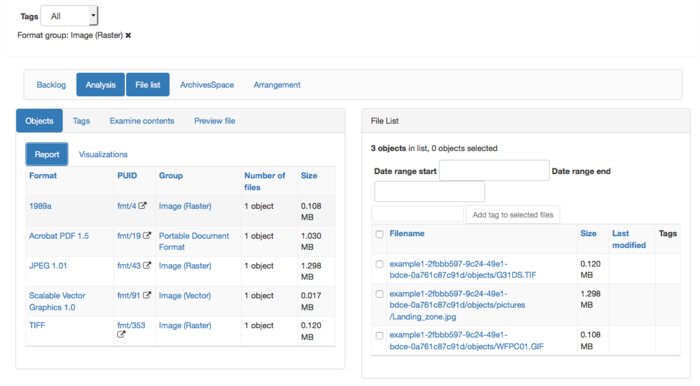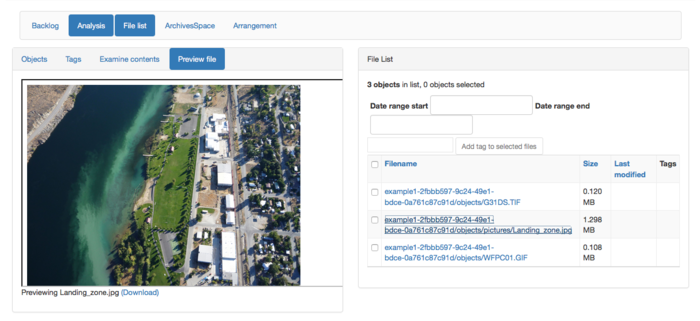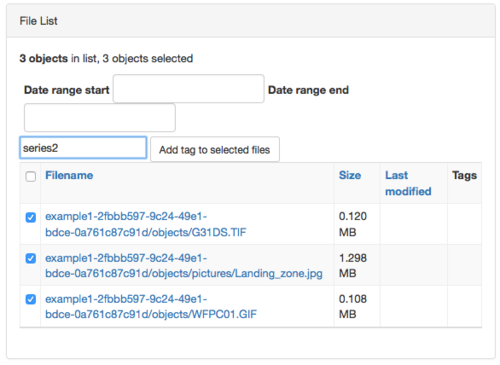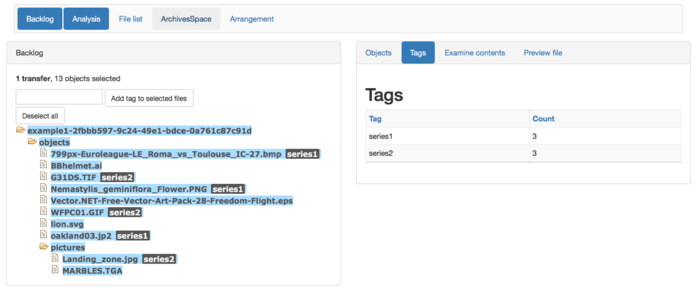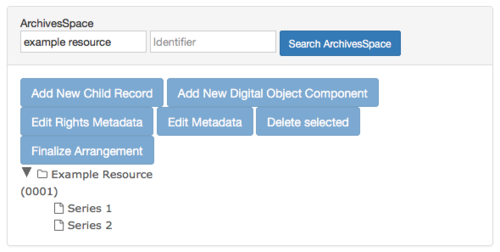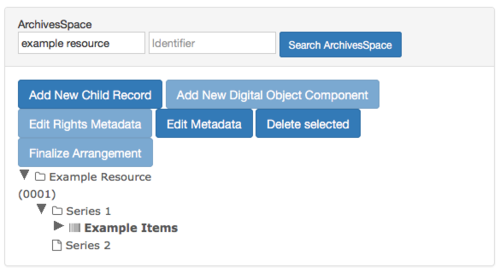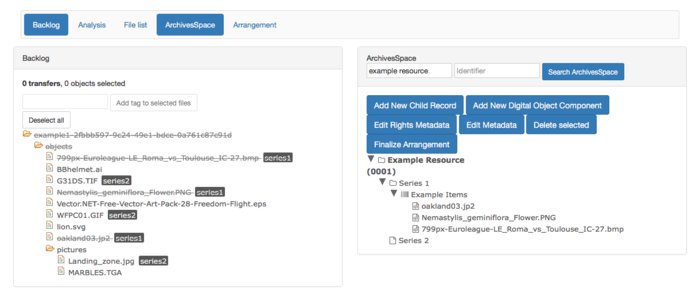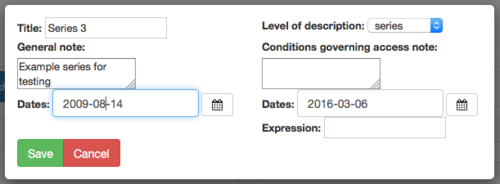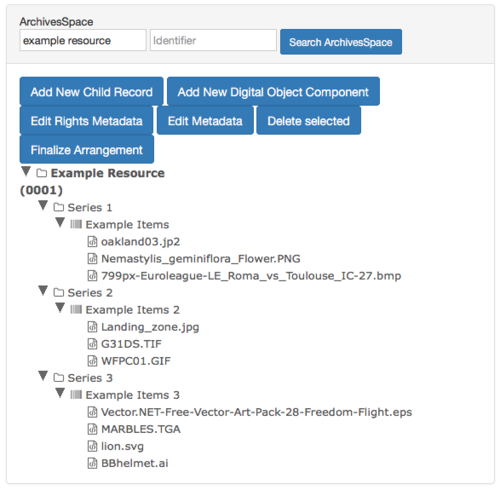Difference between revisions of "Archivematica to ArchivesSpace Workflow"
(Created page with "This page describes a basic Archivematica to ArchivesSpace workflow. It details the steps that would be taken to transfer, analyze, arrange, and create a Submission Informatio...") |
|||
| (2 intermediate revisions by the same user not shown) | |||
| Line 1: | Line 1: | ||
| + | [[Main Page]] > [[Development]] > [[Requirements]] > [[Appraisal Arrangement tab]] > Archivematica to ArchivesSpace Workflow | ||
| + | |||
This page describes a basic Archivematica to ArchivesSpace workflow. It details the steps that would be taken to transfer, analyze, arrange, and create a Submission Information Package (SIP) from files transferred to Archivematica using the Appraisal tab. | This page describes a basic Archivematica to ArchivesSpace workflow. It details the steps that would be taken to transfer, analyze, arrange, and create a Submission Information Package (SIP) from files transferred to Archivematica using the Appraisal tab. | ||
| − | + | == Send a Transfer to Backlog == | |
| + | |||
In order to work with files in the Appraisal tab, they first must be in a transfer in Archivematica’s backlog. | In order to work with files in the Appraisal tab, they first must be in a transfer in Archivematica’s backlog. | ||
1. The user provides a transfer name and uses browse to find the directory that will be transferred to Archivematica. S/he clicks “Add” and “Start transfer.” | 1. The user provides a transfer name and uses browse to find the directory that will be transferred to Archivematica. S/he clicks “Add” and “Start transfer.” | ||
| + | |||
[[Image:start_transfer.png|700 px]] | [[Image:start_transfer.png|700 px]] | ||
| + | |||
2. S/he approves the transfer and proceeds through the Transfer micro-services as needed for the particular transfer. | 2. S/he approves the transfer and proceeds through the Transfer micro-services as needed for the particular transfer. | ||
| + | |||
3. When the transfer reaches the micro-service “Create SIP from Transfer,” the user chooses “send to backlog” in the job “Create SIP(s).” | 3. When the transfer reaches the micro-service “Create SIP from Transfer,” the user chooses “send to backlog” in the job “Create SIP(s).” | ||
| + | |||
[[Image:create_SIP.png|700 px]] | [[Image:create_SIP.png|700 px]] | ||
| − | == | + | == Searching the Backlog and Adding Tags == |
Now the user must locate the transfer in the backlog. The tags feature can also be used to identify information relevant for appraisal and arrangement. | Now the user must locate the transfer in the backlog. The tags feature can also be used to identify information relevant for appraisal and arrangement. | ||
1. The user navigates to the Appraisal tab (between Transfer and Ingest) and enters search terms/parameters in the search box at the top of the page to find the transfer. | 1. The user navigates to the Appraisal tab (between Transfer and Ingest) and enters search terms/parameters in the search box at the top of the page to find the transfer. | ||
| + | |||
[[Image:searching_backlog.png|700 px]] | [[Image:searching_backlog.png|700 px]] | ||
2. The user then adds tags to identify information already known about the files. In this case, files that are part of the same series are identified. | 2. The user then adds tags to identify information already known about the files. In this case, files that are part of the same series are identified. | ||
| − | [[Image:backlog_tags.png|700 px]] | + | |
| + | [[Image:backlog_tags.png|500 px]] | ||
| + | |||
| + | == Analyzing Files Using the Analysis and File List Panes == | ||
| + | |||
| + | At this point, the user might not know enough about the files to determine their place in the arrangement or even if they belong in the SIP. The Analysis and File List panes can be used to learn more about the transfer. | ||
| + | |||
| + | 1. First, the user gains an overview of information about the files by selecting the files in the Backlog pane and clicking on Objects in the Analysis Pane. This generates a report with information such as the format and size of the files. Visualizations can also be used to gain an overview of the files. | ||
| + | |||
| + | [[Image:analysis_objects.png|700 px]] | ||
| + | |||
| + | 2. Some files need further examination. They are selected in Analysis, adding them to the File List. | ||
| + | |||
| + | [[Image:analysis_file_list.png|700 px]] | ||
| + | |||
| + | 3. The user clicks on individual files to preview them. | ||
| + | |||
| + | [[Image:analysis_preview_file.png|700 px]] | ||
| + | |||
| + | 4. After examining these files, it is clear that they form a new series. The user adds a “series2” tag to assist with arrangement. | ||
| + | |||
| + | [[Image:file_list_tags.png|500 px]] | ||
| + | |||
| + | 5. Tags now appear attached to files in the backlog. The user can also gain a sense of the scope of the two series that have been identified by clicking on “Tags” in the Analysis pane. | ||
| + | |||
| + | [[Image:analysis_tags.png|700 px]] | ||
| + | |||
| + | '''Note''': If the records contain personal information and the tool Bulk Extractor was used in Transfer, the user could use “Examine contents” to see what files were identified as having personal information. | ||
| + | |||
| + | == Arranging Files in the ArchivesSpace Pane == | ||
| + | |||
| + | Having conducted a preliminary examination of the records, the user begins to work on the arrangement, associating the records with an ArchivesSpace finding aid. The user can return to the Analysis and File List panes at any point to further explore the records as s/he works on the arrangement and description. | ||
| + | |||
| + | 1. The user opens the ArchivesSpace pane and finds the resource using the search box. Resources can be expanded to show lower levels of description. | ||
| + | |||
| + | [[Image:search_ArchivesSpace.png|500 px]] | ||
| + | |||
| + | 2. Before files can be added to a resource, a space must be created for them by adding a digital object component. The user selects Series 1 and chooses “Add New Digital Object Component” which brings up a dialog box for adding basic metadata. The new digital object appears nested under the archival object “Series 1.” | ||
| + | |||
| + | [[Image:appraisal_tab_digital_object.png|500 px]] | ||
| + | |||
| + | 3. Files in the backlog now can be arranged by dragging them to the digital object component. | ||
| + | |||
| + | [[Image:appraisal_tab_dragging_files_to_resource.png|700 px]] | ||
| + | |||
| + | 4. The user repeats this process to add items that belong in Series 2. | ||
| + | |||
| + | 5. The user also determines that other files in the transfer form a new series, which had not been described when the resource was created in ArchivesSpace. By selecting the resource (highest level of description) and using the “Add New Child Record” button the user can create another series. | ||
| + | |||
| + | [[Image:appraisal_tab_new_child_record.png|500 px]] | ||
| + | |||
| + | '''Note''': If the user wants to make changes to the description while working in the ArchivesSpace pane, s/he can also use the “Edit Metadata” button to change metadata for an existing item. “Edit Rights Metadata” provides a form for adding PREMIS rights. Mistakenly added archival objects can be deleted. | ||
| + | |||
| + | 6. Finally, the user creates a SIP from the arrangement. A SIP is sent to Ingest by selecting the resource (highest level of description) and clicking “Finalize Arrangement.” | ||
| + | |||
| + | [[Image:appraisal_tab_ArchivesSpace.png|500 px]] | ||
Latest revision as of 18:37, 13 April 2016
Main Page > Development > Requirements > Appraisal Arrangement tab > Archivematica to ArchivesSpace Workflow
This page describes a basic Archivematica to ArchivesSpace workflow. It details the steps that would be taken to transfer, analyze, arrange, and create a Submission Information Package (SIP) from files transferred to Archivematica using the Appraisal tab.
Send a Transfer to Backlog[edit]
In order to work with files in the Appraisal tab, they first must be in a transfer in Archivematica’s backlog.
1. The user provides a transfer name and uses browse to find the directory that will be transferred to Archivematica. S/he clicks “Add” and “Start transfer.”
2. S/he approves the transfer and proceeds through the Transfer micro-services as needed for the particular transfer.
3. When the transfer reaches the micro-service “Create SIP from Transfer,” the user chooses “send to backlog” in the job “Create SIP(s).”
Searching the Backlog and Adding Tags[edit]
Now the user must locate the transfer in the backlog. The tags feature can also be used to identify information relevant for appraisal and arrangement.
1. The user navigates to the Appraisal tab (between Transfer and Ingest) and enters search terms/parameters in the search box at the top of the page to find the transfer.
2. The user then adds tags to identify information already known about the files. In this case, files that are part of the same series are identified.
Analyzing Files Using the Analysis and File List Panes[edit]
At this point, the user might not know enough about the files to determine their place in the arrangement or even if they belong in the SIP. The Analysis and File List panes can be used to learn more about the transfer.
1. First, the user gains an overview of information about the files by selecting the files in the Backlog pane and clicking on Objects in the Analysis Pane. This generates a report with information such as the format and size of the files. Visualizations can also be used to gain an overview of the files.
2. Some files need further examination. They are selected in Analysis, adding them to the File List.
3. The user clicks on individual files to preview them.
4. After examining these files, it is clear that they form a new series. The user adds a “series2” tag to assist with arrangement.
5. Tags now appear attached to files in the backlog. The user can also gain a sense of the scope of the two series that have been identified by clicking on “Tags” in the Analysis pane.
Note: If the records contain personal information and the tool Bulk Extractor was used in Transfer, the user could use “Examine contents” to see what files were identified as having personal information.
Arranging Files in the ArchivesSpace Pane[edit]
Having conducted a preliminary examination of the records, the user begins to work on the arrangement, associating the records with an ArchivesSpace finding aid. The user can return to the Analysis and File List panes at any point to further explore the records as s/he works on the arrangement and description.
1. The user opens the ArchivesSpace pane and finds the resource using the search box. Resources can be expanded to show lower levels of description.
2. Before files can be added to a resource, a space must be created for them by adding a digital object component. The user selects Series 1 and chooses “Add New Digital Object Component” which brings up a dialog box for adding basic metadata. The new digital object appears nested under the archival object “Series 1.”
3. Files in the backlog now can be arranged by dragging them to the digital object component.
4. The user repeats this process to add items that belong in Series 2.
5. The user also determines that other files in the transfer form a new series, which had not been described when the resource was created in ArchivesSpace. By selecting the resource (highest level of description) and using the “Add New Child Record” button the user can create another series.
Note: If the user wants to make changes to the description while working in the ArchivesSpace pane, s/he can also use the “Edit Metadata” button to change metadata for an existing item. “Edit Rights Metadata” provides a form for adding PREMIS rights. Mistakenly added archival objects can be deleted.
6. Finally, the user creates a SIP from the arrangement. A SIP is sent to Ingest by selecting the resource (highest level of description) and clicking “Finalize Arrangement.”
